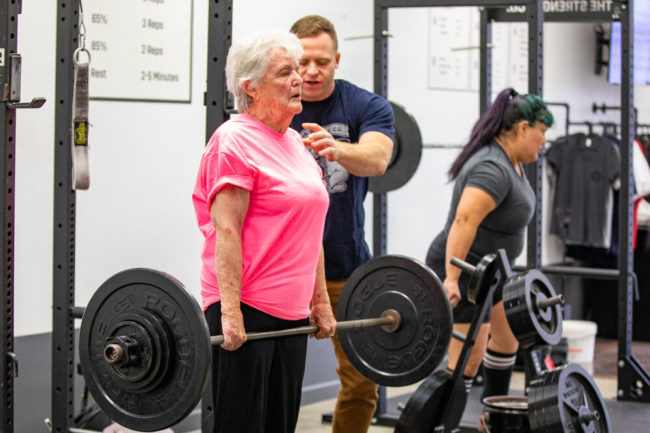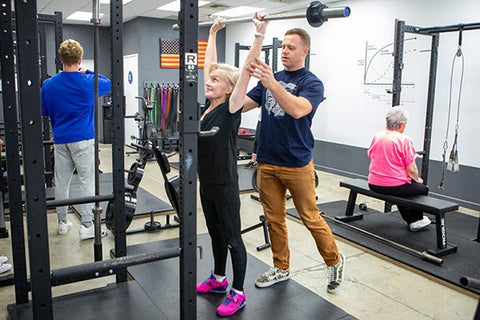Capt Grant Broggi, SSC
Originally posted on Starting Strength
I have learned quite a bit during my last ten years of barbell coaching. I first began by coaching young Marines, mostly men aged 18-22 before beginning to coach the public out of my garage, and then ultimately two gyms. I’ve observed lots of lifters hitting weights they’ve never thought possible, simply by doing the basic barbell exercises laid out in the book Starting Strength: Basic Barbell Training 3rd edition. I’ve taken lifters to competitions, coached NFL players, and watched many heavy deadlifts; yet, out of all the people I have coached, I have found that coaching my older clients is the most rewarding.
This group sees an immediate impact on quality of life, and if done correctly, can drastically slow the aging process. Yet while the older population has the greatest need for strength training, they can be some of the most difficult to convince to do it.
Today I’ll share with you some of things I’ve learned coaching the 60, 70, and 80+ crowd. I’ll start with Corki, an 86-year-old friend of mine, and finish with Earlene, a 74-year-old whose children convinced her to lift. I’ll share how we got them to the barbell, and then what we did once we got them there.
Corki, 86, Owner of Corki’s Embroidery

Corki is an 86-year-old business owner and a family friend of mine. Her embroidery shop has been in business for over 40 years and she still runs it four days a week. As a matter of fact, if you’ve gotten a hat from The Strength Co., Corki sewed your patch on!
I was picking up an order from Corki one day and I noticed her face was bruised. Corki had recently fallen, landing partly on her face and putting her out of commission for a few weeks. I asked her how she fell, and it was a story that all of us who have older loved ones are familiar with: tripped on such and such, and then just “lost my balance.”
A fall is much more costly for a person in their 80s. The deterioration of balance due to a loss of strength has not only caused the fall, but also leaves the person unable to absorb the impact of the fall. Loss of muscle, weaker ligaments and tendons, and more brittle bones are now all at risk. Falls can be very scary.
As I chatted with Corki she talked about how she was on the mend and happy to be back at work. I mentioned to her that strength training could help her balance (and keep her from falling). This resonated with Corki because her fall made her miss work, the business that she intends to keep running. She doesn’t like to miss work, so Corki agreed to come train.
Getting Started

In both of my gyms we have a very standardized process to teach new lifters how to get strong. They come in, and we teach them how to squat, press, and deadlift. These are the cornerstone lifts of the Starting Strength program, and it is important that a new lifter grasps these movement patterns on their first day.
At 86, when Corki walks into the gym for the first time, things look a little bit different than when a random 40-year-old walks in. We have two goals on her first day: 1) find her current baseline of strength, and 2) make her confident that she can get stronger. The baseline part is easy, we’ll talk about that in a bit. But the most important thing is that Corki leaves with the belief that even though she is weak now, she can improve with some hard work and become strong once again.
One of the ways we evaluate someone like Corki is just by watching her as she enters the gym. Does she open the door confidently? What’s the speed of her gait? Does she steady herself as she goes to take a seat on the bench? Does she grimace when she sits down? These are all things that happen to people as they age, and they are a result of one thing: a loss of strength. So as I watch Corki, I’m assessing her baseline of strength so I can decide where to begin her training.
Can Old People Squat?
One of the things that Corki told me right away was that she had trouble with her knees. This is a very common sentiment with lifters 60+, particularly with those in their 70s and 80s. Some sort of arthritis has usually set in, reminding them that they are not as young as they once were every time they use their knees.
As a result of this I usually do not begin by having them squat. Although I have every intention of adding it back in down the road. I have found that keeping the first few sessions very simple and making the lifter feel successful is more beneficial than getting through more movements.
I generally start an older de-trained client with a rack pull (an elevated deadlift), or a deadlift if they prove to have enough strength and range of motion to pull at least 35lbs from the floor. The deadlift is a phenomenal exercise for strength training and simple enough to complete for an older adult. If they are not strong enough to deadlift, the rack pull provides the same mechanics as the deadlift but artificially raises the bar, shortening the range of motion and making it easier to put the low back into extension (make it flat).
With Corki, we started with a 15 lb rack pull just above the knee and went to full lockout at the top. We rested a few minutes between sets, and that was it. From there it was a very simple process. The goal of the following sessions would be to slowly bring the bar down to the floor until she could perform a deadlift. Sometimes you get there in a few sessions, sometimes a couple of weeks, sometimes over a month. It all depends how de-trained the lifter is, their consistency, and their desire to get better. The key for Day One is to avoid too much volume. If a lifter is very de-trained, doing more than 3 sets of 5 (including warmups) can put the lifter’s body into shock. It may not feel heavy, and may not feel like a lot of work, but be conservative.
Once the bar is on the floor you’re off to the races. Older lifters tend to respond really well to 2x/wk training and small jumps of 1-3 lbs are perfect for the very de-trained lifter. Be patient, build their confidence, and show them their progress week to week, although they will feel it too. Corki went from a 15 lb rack pull to her current 100 lb deadlift in just about 6 months time.
Earlene, 70, and “Pilates Fit”

I have written and talked about quite a few times about getting my parents to lift. So when opportunities arise to help other children do the same thing, I take them seriously. A few weeks ago I received a call from a ER physician down in San Diego. He and his wife (also an ER physician) had discovered the book Starting Strength and had begun training. He called to discuss his training and a good time to come up for our Intro to Barbells class. Towards the end of the call he said “Do you guys work with people in their 70s, by chance?”
I told him that of course we did, and he told me he wanted his mother to learn how to lift. She was 74, had a healthy bodyweight, did Pilates, but had seen her strength begin to deteriorate. He said that while she wasn’t opposed to lifting, she was not that open to it. I asked the son where she lived and realized she was about 15 minutes away from my gym. I asked him if he thought she would “come watch” while they did their session. I told him to tell her she wouldn’t have to lift or workout or do anything, but she could come see the facility and watch them train. She agreed.
Getting people in the door is often the hardest part of the whole process. Once they begin training and seeing the benefits the hard part becomes getting them to leave after their session. So my approach with his mother was to get her in the door with no strings attached, just so she could see what it was all about.
When Earlene came in that day I could tell the gym was a bit scary. A petite woman, the barbells seemed large and I’m sure the weights all looked heavy. But then she watched as a few of the coaches began to take her son and wife through the squat. She noticed that they started with an air squat, and then an empty bar and that everything was monitored and controlled.
As the coaches worked with her kids I went over and began to talk to her. I asked her what some of her ailments were. She told me she had had terrible SI Joint pain in the past, leading to lower back pain and even pain down the leg. She began a strict eating regiment that had helped her overall health but hadn’t helped her strength.

We continued to observe her children lifting, and about the time they finished up with the press I asked her to follow me to the back of the room. She came back and while we chatted I set up a rack pull then mid-conversation asked her to step up to it. “You think I’m going to lift that?” “Yes.” I replied. She bent at the waist and drug the empty bar up her legs 5 times. She put it down, smiled, and said “I really can do this.”
I followed up with Earlene a week or so later and she has now finished her first month of training. Her deadlift is up to 55 lb, she’s pressing 27.5, and just this week she began squatting with a 15 lb bar. She also no longer attends one on one sessions with me but trains in a group class with lifters of all ages.
She’s capable. She’s getting stronger.
You Don’t Have To Be A Coach
These stories are not special – I am not a “barbell whisperer.” Convincing the older population to lift can be difficult, but it is doable. “You should deadlift” is probably not the most convincing argument, but explaining muscular atrophy by showing day-to-day examples might be.
I’d be remiss if I didn’t tell you that I evaluated Corki and Earlene the same way I would my own grandmother. You may not be a coach, but what you may be is a caring child or grandchild. And it’s been my experience that caring children and grandchildren want grandmas to live a long time. Strength is a big part of that. So after observing some of the movements of your loved one, you can point out to them some of the basic everyday activities that would be improved by an increase in strength.
As you age, you get weaker, unless you do something about it. I’m happy for these ladies, and I look forward to continuing to help them get stronger.
